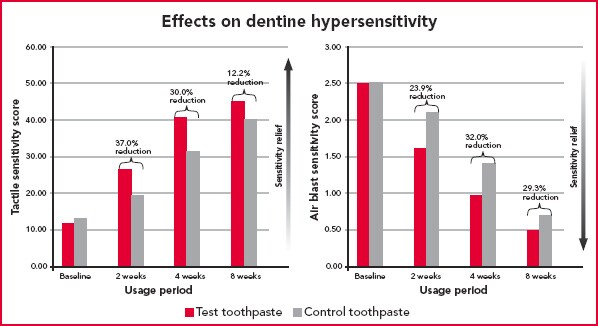
Pro Argin® Toothpaste Efficacy - Docimo
et al Summary
Reading tme: 3 minutes
Authors: R Docimo1, L Montesani1, P Maturo1, M Costacurta1, M Bartolino1,
W DeVizio2, YP Zhang2, D Cummins2, S Dibart3, and LR Mateo4
Comparing the Efficacy in Reducing Dentin Hypersensitivity of a New Toothpaste Containing 8.0% Arginine, Calcium Carbonate, and 1450 ppm Fluoride to a Commercial Sensitive Toothpaste Containing 2% Potassium Ion:An Eight-Week Clinical Study in Rome, Italy
In: J Clin Dent 2009 (Spec Iss); 20: 17–22
1 University of Rome at Tor Vergata, Rome, Italy
2 Colgate-Palmolive Technology Center, Piscataway, NJ, USA
3 Boston University School of Dental Medicine, Clinical Research Center, Boston, MA, USA
4 LRM Consulting, Hoboken, NJ, USA
Study objective:
The objective of the double-blind, randomized study conducted in Rome, Italy, was to compare a new toothpaste containing 8% arginine, calcium carbonate and 1450 ppm fluoride as sodium monofluorophosphate (MFP) and a commercial toothpaste containing 2% potassium ion and 1450 ppm fluoride as sodium fluoride (NaF) with respect to the reduction of dentine hypersensitivity over an eight-week period.
Trial conditions and methods
Products under investigation
Test: A new toothpaste (Colgate-Palmolive Inc., NY) containing 8% arginine, calcium carbonate and 1450 ppm fluoride as MFP. Control: Commercially available desensitising toothpaste containing 2% potassium ion as 3.75% potassium chloride and 1450 ppm fluoride as NaF in a silica base (Sensodyne Total Care F, GlaxoSmithKline, Middlesex, UK)
Study subjects
A total of 80 adult male (n= 24) and female (n= 56) subjects with a mean age of 42.2 ± 10.6 years (age range 19 – 69 years) with established dentine hypersensitivity on at least two hypersensitive teeth with a tactile sensitivity score of 10 to 50 grams of force (Yeaple probe) and an air blast stimulus score of 2 or 3 (Schiff Cold Air Sensitivity Scale).
Methods
In this double-blind, parallel-group study, the 80 subjects with established dentine hypersensitivity were stratified according to their tactile and air blast stimulus scores at baseline and then randomly assigned within strata to either the test (n = 40) or control (n = 40) group. Subjects were instructed to brush their teeth twice a day (morning and evening) for 1 min each time. Tactile and air blast sensitivity assessments were repeated at 2, 4, and 8 weeks. Statistical analyses were done separately for tactile and air blast scores. Within-group comparisons were done using paired t-tests. Comparisons between treatments using baselineadjusted scores were performed using analysis of covariance (ANCOVA).
Results
When used over a period of 8 weeks, the novel toothpaste containing arginine and MFP in a calcium carbonate base significantly reduced dentine hypersensitivity (p < 0.05) in response to both the tactile and air blast stimuli. Compared to the commercial toothpaste with 2% potassium ion and NaF, the arginine containing toothpaste was significantly (p < 0.05) more effective in reducing hypersensitivity scores after 2, 4, and 8 weeks of use (37.0%, 30.0%, and 12.2% for tactile stimuli; 23.9%, 32.0%, and 29.3% for air blast stimuli).
Conclusion
A new toothpaste with 8% arginine, calcium carbonate and 1450 ppm fluoride (MFP) provided significantly (p < 0.05) greater dentine hypersensitivity relief after 2, 4, and 8 weeks of use than a desensitising toothpaste containing 2% potassium ion and 1450 ppm fluoride (NaF).


